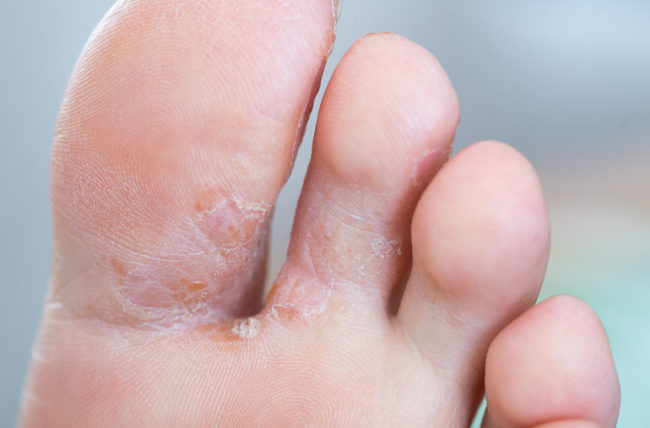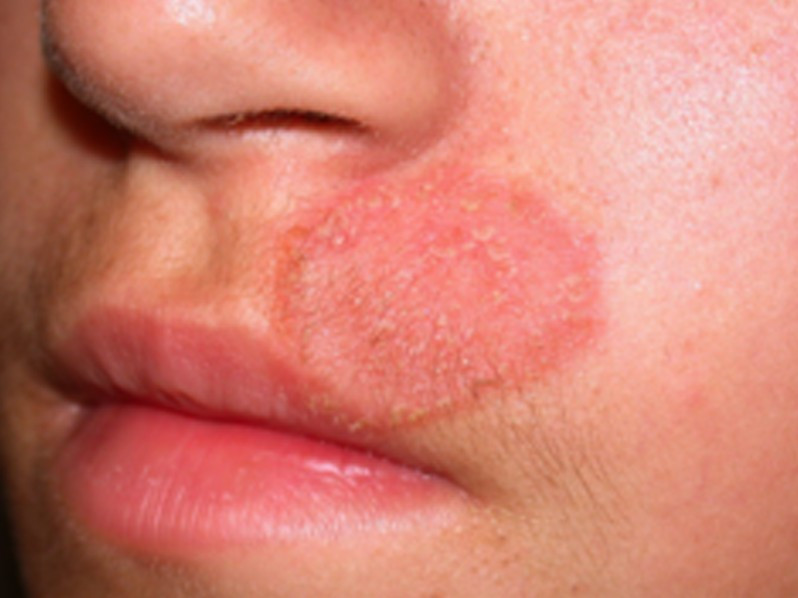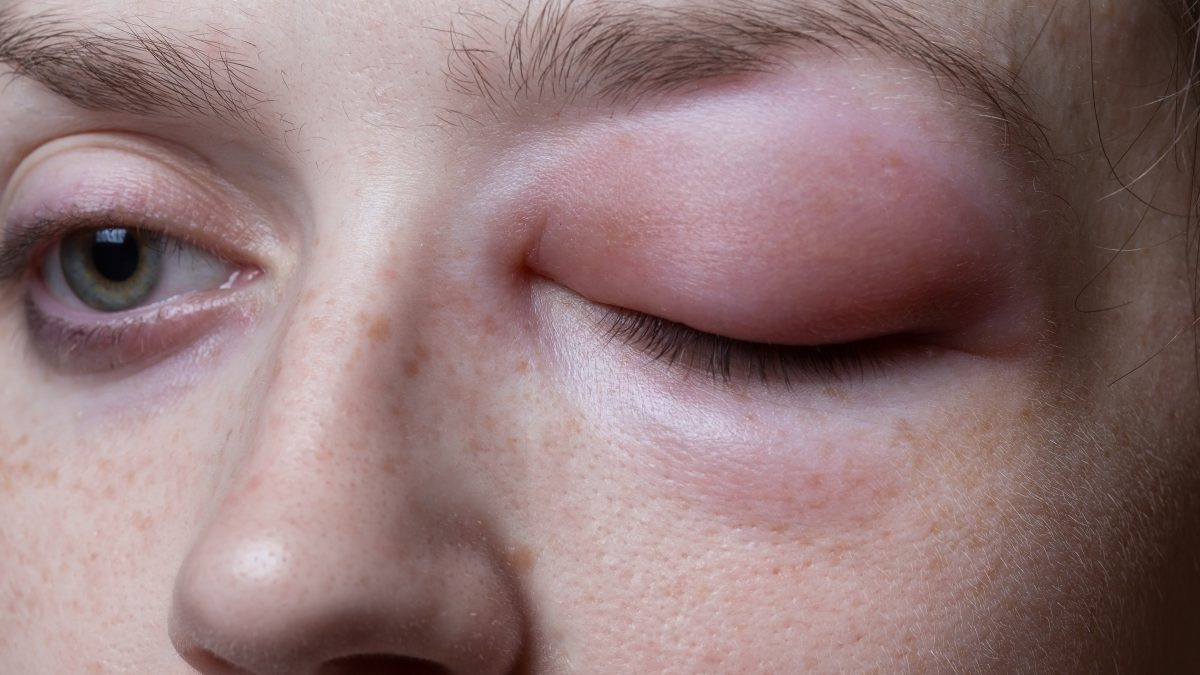Definition
Tinea pedis is a fungal infection that typically occurs in the interdigital spaces of the foot. Tinea refers to a group of fungal infections, while "pedis" is derived from Latin and specifically refers to the foot. Approximately 10% of the global population has either experienced or is already experiencing this fungal illness. Typically, this infection originates in individuals who sweat on their feet while wearing constricting footwear, such as athletes. Hence, this infection is sometimes referred to as "athlete's foot".
Causes
Tinea pedis is caused by fungi known as dermatophytes. These fungi consist of the Trichophyton, Epidermophyton, and Microsporum groups. The main cause of fungal infections on the feet is the fungal species Trichophyton rubrum, which infects around 70% of all tinea pedis sufferers. This fungal infection develops most in damp and warm conditions. This fungus produces substances that can damage the keratin layer of the skin, and the infection is limited to that layer.
The infection can be transmitted through direct contact with infected individuals or indirect contact with materials contaminated with the fungus, such as towels, floors, and shoes. If the skin on your feet is scratched or peeled, this infection could spread to other areas.
Risk factor
Factors that could promote fungal growth on human feet and increase your risk of developing tinea pedis include:
- Warm and humid environment
- Long-term use of occlusive footwear
- Sweating a lot
- Prolonged exposure to water
- Sharing carpets, footwear, linens, clothing, or shoes with other individuals.
- Walking barefoot in areas with a high likelihood of fungal presence, such as locker rooms, saunas, swimming pools, and public baths
Symptoms
Tinea pedis can appear on one or both feet. Signs and symptoms commonly reported and frequently expressed by patients include:
- The skin of interdigital spaces of the foot exhibiting scaliness, peeling, or dryness
- Pruritus, particularly following the removal of footwear and socks
- Skin inflammation is characterized by skin discoloration to red, purplish or gray, depending on the individual's skin color
- Experiencing sensations of burning or sharp sting
- There could be found blisters in the affected foot area
- The foot exhibits dry and flaky skin, primarily affecting the soles and potentially extending to the sides
- The area affected by the fungal infection has an unpleasant odor
- Frequent scratching of the foot can lead to significant skin peeling
Diagnosis
The diagnosis of tinea pedis can be established by considering the patient's symptoms, medical history, daily routines, and various examinations. The doctor will inquire about the symptoms and problems you are experiencing, the initial state of your feet when the illness first manifested, and any habits that may have contributed to the onset or exacerbation of the condition. Typically, the doctor would physically examine the foot to inspect the affected region.
Under certain conditions, your doctor may advise you to have a skin scraping examination. The skin in the affected area will be scraped. Subsequently, drops of potassium hydroxide (KOH) will be added to the sample. It will be examined under the microscope. This test is conducted to determine the specific type of fungus that is causing an infection on the skin of your foot.
An alternative test that can be conducted is a fungal culture, although it is not used as a standard procedure due to its time-consuming nature. During the procedure, the skin is scraped, and the samples are subsequently cultivated in a container and allowed to incubate for several days. In the presence of a genuine fungal infection, the container will become populated with fungus after a few days.
Management
Antifungal medicines are the primary treatment for tinea pedis. Typically, patients will be prescribed topical ointments, applied twice daily for 1-6 weeks. Additionally, you may be prescribed oral antifungal medicine. Nevertheless, these treatments are exclusively administered under specific circumstances, such as when an infection develops in the back of the foot or in cases of recurring fungal infections.
Infection control is another aspect of treatment. For instance, swimming pools and public baths should be cleaned regularly. When visiting a swimming pool or public bath, it is advisable to wear footwear to minimize the risk of transmission or infection. In addition, if you have contracted a fungal infection, it is imperative that you promptly wash the clothes and towels that you wear.
If your daily activities necessitate prolonged use of footwear, it may be advisable to apply antibacterial powder after bathing. In addition, it is essential to frequently cleanse and thoroughly dry your feet to prevent the occurrence of fungal infections. It is crucial to take measures to avoid the recurrence of tinea pedis on your foot. Regularly applying antifungal ointment to your skin may be necessary, particularly if you wear tightly fitted footwear.
Complications
Tinea pedis has the potential to spread to other areas of the body, particularly warm and moist body areas. An instance of the spread of fungal infections is tinea cruris, a fungal infection that manifests in the genital area and the thigh. This problem typically arises when the fungus spreads from the feet to the area between the thighs, often by touching the infected feet with hands or towels and subsequently touching the thighs or body.
Besides that, fungal infections can also be accompanied by bacterial infections. Bacterial infections may lead to skin complications, such as:
- Infection of the outermost layer of the skin
- Cellulitis is an infection that affects the connective tissue beneath the skin
- Lymphangitis is a condition that refers to the infection or inflammation of the lymph vessels
- Osteomyelitis or bone infection
The aforementioned complications typically arise in individuals with compromised immune systems or limited mobility
Prevention
You can prevent tinea pedis by following these:
1. Allow the feet to ventilate
If feasible, you may opt to wear sandals to maintain adequate air circulation around your feet.
2. Cleanse your feet daily
Wash your feet with warm water and soap to cleanse your feet, thoroughly rinse and dry them, and pay attention to the interdigital spaces of your feet. If you are at risk for fungal infections, you can apply a drying powder on your feet.
3. Replace socks often
It is advisable to regularly replace your socks, ideally daily, or more frequently if you sweat a lot. Your feet would be dry by wearing cotton socks that absorb water easily, compared to nylon socks.
4. Wear different shoes every day
Wear different shoes daily to allow sufficient time for the shoes to dry.
5. Protect your feet when in public areas
Wear sandals or waterproof footwear in swimming pools, bathing places, and public lockers.
6. Take into consideration your potential for transmitting infection
To prevent the spread of germs, refrain from exchanging shoes and towels with other people. Avoid using the same sheets if possible.
When to see a doctor?
If you have a persistent skin lesion on your foot that fails to heal within two weeks or more, even after you have applied or drunk medicines, you are advised to seek medical advice from a doctor. If you have diabetes, you can consult a doctor on the potential occurrence of tinea pedis. If you observe any indications of infection in your foot, such as swelling, pus discharge, or fever, you are also advised to consult a doctor.
Looking for more information about skin and other hair diseases? Read more articles here!
- dr Hanifa Rahma
Athlete's foot - Symptoms and causes. (2021). From https://www.mayoclinic.org/diseases-conditions/athletes-foot/symptoms-causes/syc-20353841 [Accessed March 19, 2022]
Nigam, P., & Saleh, D. (2021). Tinea Pedis. From https://www.ncbi.nlm.nih.gov/books/NBK470421/ [Accessed March 19, 2022]
Robbins, C. (2020). Tinea Pedis: Background, Pathophysiology, Epidemiology. From https://emedicine.medscape.com/article/1091684-overview [Accessed March 19, 2022]












